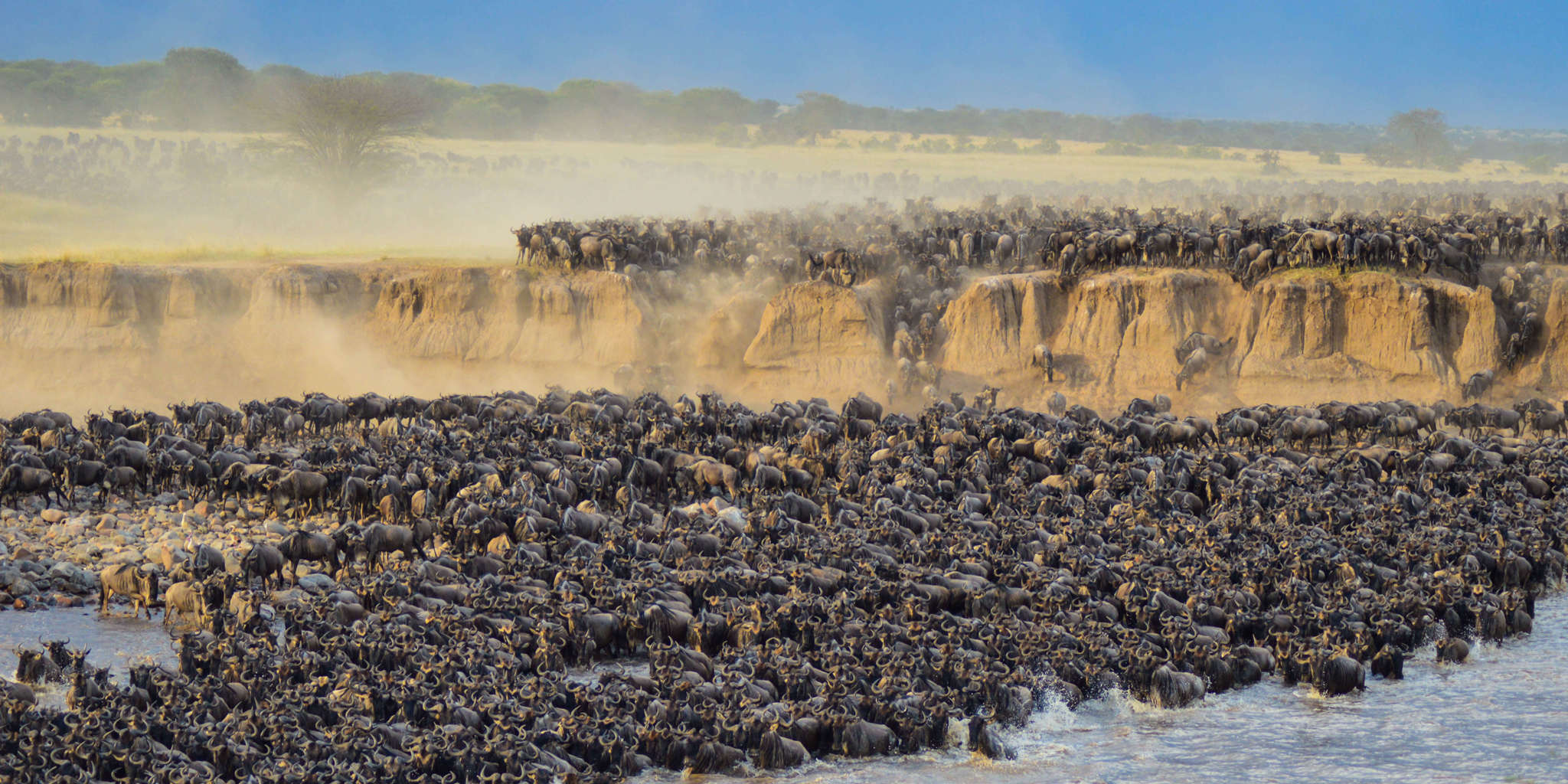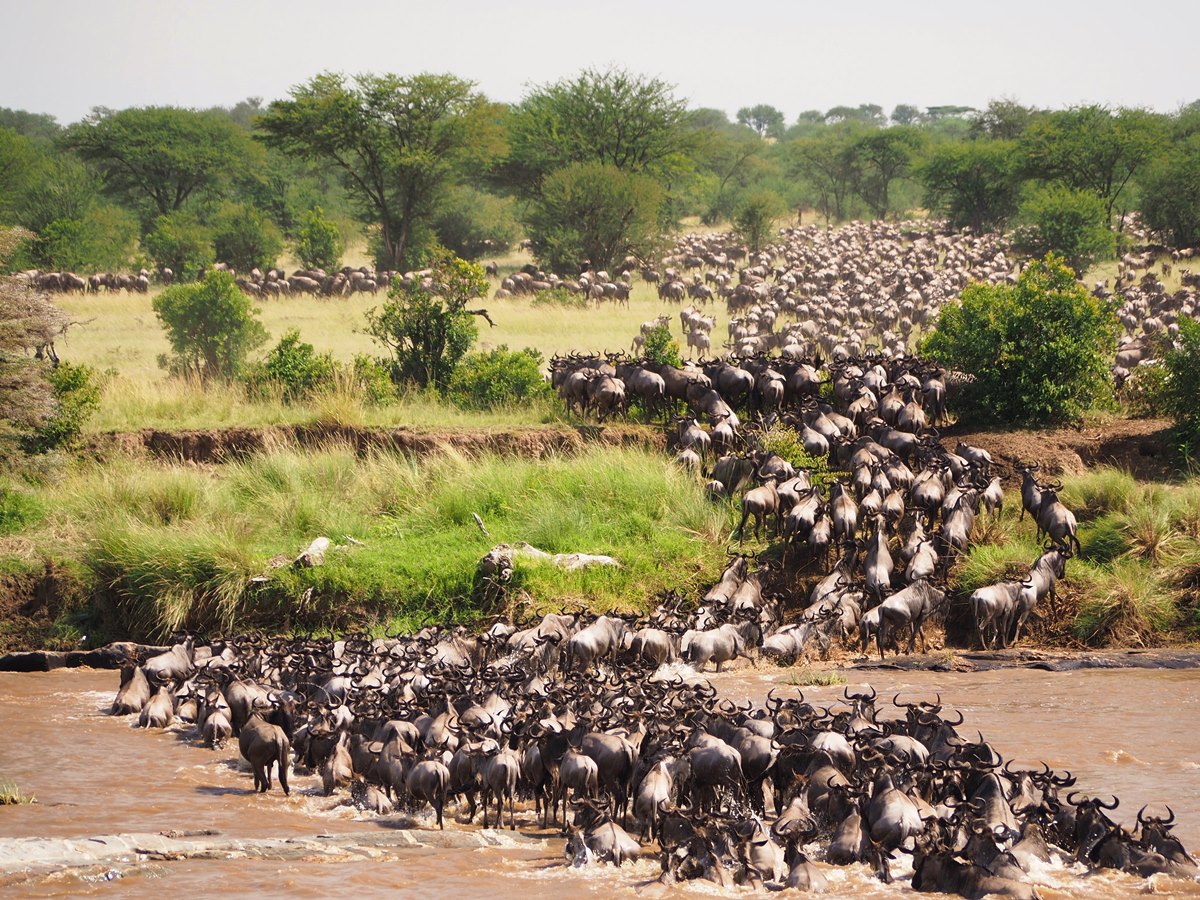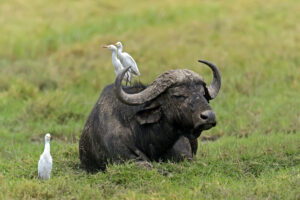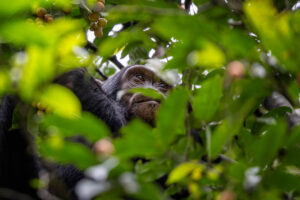Every year, millions of wildebeest, zebras, and antelopes embark on a breathtaking journey across the Serengeti in Tanzania and the Masai Mara in Kenya. This cyclical migration follows the rains, ensuring access to fresh grazing and continuing a timeless survival story.

This movement sustains a delicate ecosystem, supporting not just herbivores but also predators like lions, cheetahs, leopards, and hyenas. Dubbed “The Greatest Show on Earth,” the migration attracts wildlife enthusiasts from around the world. Here’s everything you need to know to plan your unforgettable Great Migration safari.
Best Time to Witness the Migration
While the migration happens year-round, some moments stand out:
- Calving Season (January – March): Thousands of wildebeest give birth almost simultaneously in the Southern Serengeti, attracting predators.
- River Crossings (July – September, late October – November): Witness dramatic Mara River crossings as herds face strong currents and lurking crocodiles.

Top Locations to Experience the Migration
The migration covers roughly 2,000 kilometers across northern Tanzania and southern Kenya. The best locations to witness this phenomenon include:
- Seronera (Central Serengeti): Year-round game viewing with good chances of seeing predators.
- Western Corridor & Grumeti Reserve: Known for its Grumeti River crossings, occurring from May to July.
- Northern Serengeti & Mara River: The best place to see dramatic crossings between July and September.
- Masai Mara (Kenya): Between August and October, herds move north before returning to Tanzania.
[Include a close-up image of wildebeest in motion]
Accommodation Options
Tanzania offers a range of accommodations, catering to different preferences:
- Luxury Lodges & Permanent Tented Camps: High-end facilities with premium service and comfort.
- Mid-Range Camps: Comfortable accommodations blending adventure and affordability.
- Mobile Tented Camps: Positioned along migration routes for an immersive experience.
- Budget Camping Safaris: A more affordable and adventurous way to witness the migration.
Tip: Since this is peak season, book accommodations well in advance to secure your preferred choice.
How Long Should You Stay?
The migration is unpredictable, so the longer you stay, the better your chances of witnessing spectacular events. A minimum of four to five days is recommended to experience different aspects of the migration.
When to Book Your Great Migration Safari
Demand for migration safaris is incredibly high, with bookings made up to a year in advance. For the best experience, secure your flights, accommodations, and safari package at least six months ahead. Being flexible with travel dates increases your chances of witnessing peak migration activity.
Tip: Check your safari operator’s cancellation policies in case of unforeseen changes.
What to Look for in a Safari Operator
Choosing an experienced safari operator is crucial for an exceptional experience. Consider:
- Local expertise with knowledgeable guides.
- A strong reputation backed by positive reviews and a proven track record.
- Small group sizes for flexibility and personalized experiences.
- Sustainability practices to ensure ethical tourism.
What to Expect on Safari
Your migration safari will typically include:
- Game Drives: Either twice daily (morning and afternoon) or full-day excursions with packed lunches.
- Safari Vehicles: Customized 4x4s with pop-up roofs, large windows, first-aid kits, field guidebooks, binoculars, and coolers.
- Wildlife Sightings: Expect long periods of quiet before sudden bursts of activity.
- Crowded Sightings: Popular migration spots may have multiple vehicles—communicate with your guide for alternative viewing spots.
Photography Tip: If you have extensive camera gear, consider booking a private safari vehicle for flexibility.
Enhancing Your Migration Safari
Beyond traditional game drives, consider adding these activities:
- Hot-air balloon safari: A breathtaking aerial view of the migration.
- Walking safari: Available in specific areas for a more immersive experience.
- Cultural visits: Engage with local Maasai communities.
- Sundowners: Enjoy drinks at scenic locations.
- Beach extension: Relax in Zanzibar after your safari.
- Additional parks: Explore Ngorongoro Crater, Tarangire, or Ruaha for diverse wildlife encounters.
Final Thoughts
A Great Migration safari is a once-in-a-lifetime experience that requires careful planning. By choosing the right time, location, accommodation, and safari operator, you can maximize your chances of witnessing this natural wonder in all its glory.
Ready to embark on the adventure of a lifetime? Start planning your Tanzanian safari today!
[Include an inspiring closing image of the Serengeti at sunset]










